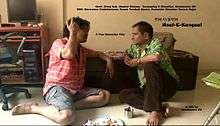Haal E Kangaal
| Haal-E-Kangaal | |
|---|---|
 | |
| Directed by | Ramchandra P. N. |
| Produced by | Sonk Films |
| Written by | Ramchandra P. N. |
| Starring | Niraj Sah, Hemant Mahaur |
| Cinematography | Narayanan Venkataraman |
Running time | 105 minutes |
| Country | India |
| Language | Hindi |
Haal-E-Kangaal (Hindi: हाल ए कंगाल, English: The Bankrupts) is a Hindi language feature film that is completed in 2015. The film is shot in a single location - a suburban flat in the city of Mumbai. The film uses the services of just two actors. It is one of those few two character films made over the world.
The story, screenplay and direction of Haal-E-Kangaal is by Ramchandra PN, a graduate of the Film and Television Institute of India, Pune. His earlier film Suddha had won the best Indian film at the Osean Cinefan Festival of Asian Films, New Delhi, 2006 and his second feature Putaani Party had won the Best Children's Film at the Indian National Film Awards for the year 2009.
Plot
Two struggling filmmakers meet after a gap of fifteen years and amidst celebration, enmity and jealousy realise that they are as bankrupt as every before - in all sense of the word.
The film is a Black Comedy that is a humorous account of the artistic and intellectual bankruptcy of independent film making scene that presently exists in India. In a larger context, the film subtly debates the role of an filmmaker / artist in a highly competitive self centric world.
"Normally a film would have many locations, numerous characters and many dramatic twists in the plot. But 'The Bankrupts' treads an off beat path that is often not traveled by many. The entire film is set in one location inside a flat in a housing society in the city of Mumbai and starred by only two actors.. It is very rarely that we see films that have only two characters set in a single location."(Source: Manglorean.com Site)[1]
Since the film is on film makers who have studied in film schools, the film was shown to film students in a few film schools, mainly in Film and Television Institute of India, Pune and the Manipal Institute of Communications, before it was finalised.[2]
Shrikant Prabhu's review
Shrikant V Prabhu has written a review of the film on the Indian film website upperstall.com where he talks about the techniques used in the film.
"The camera easily lives and breathes in small spaces in the film. The wide angle lens creates a weird cocoon showing the two individuals hopelessly trapped. The jump cuts as a narrative device give you that interrupted feel and suggest the implausibilities in the narrative. The sound design has created a well-thought out fabric of a familiar world."(Source: Upperstall.com Site)[3]
Cast
(Source: Upperstall.com)[9]